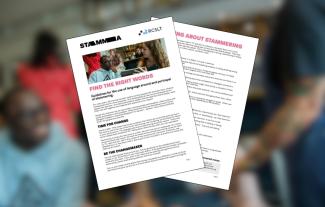
Download our guidelines for talking about stammering.
We need to help people who don't stammer understand that stammering is how some people talk. End of.
It's not about nerves. People who stammer aren't all 'suffering', and don't all see it as something that needs 'fixing'.
We need to put an end to the idea that you have to be fluent to be accepted. The idea that stammering isn't acceptable and shouldn't be heard has no place in today's society.
As the world continues to build a more culturally inclusive environment, it's time our diversity is embraced, is visible and most especially is heard and audible. On the TV, on the radio, on film, in the workplace, in education.
Download our Editorial Guidelines for Talking About Stammering below.
Click on the above link to download the set of guidelines, which have been endorsed by the Royal College of Speech & Language Therapists.
Use them on your broadcast. Take them to your school, uni or workplace. Pin them on the noticeboard, email them to your local radio station. And when people cross the (guide)lines, let them know. Point out which line they crossed.
Change is rarely accomplished by one person, one campaign. Our strength is in our numbers. Wherever you are in your journey, help educate those around you and those you encounter. It's how you talk.
Together let's create a world where stammering is accepted as a difference, so that all those who follow can grow up and live in a world where they are treated with respect and dignity.
Go to our About Stammering section to learn more about stammering.






























